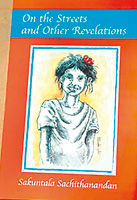At the core of my experience of Sakuntala Sachithanandan’s book of poems is the intensely human Displaced, firmly and vividly contextualized in the most terrifying experiences of our people in our time.
The displaced person is Nages, short for Nageswary, and the poem’s structure has the basic frame of her being questioned by a “pretty soldier” registering her in a camp for the displaced.
The first question asking for her name, “Unguda peyerenna?” evokes a flood of memories and reflections. She remembers that she too had been a “quite pretty” and how she’d “played the veena in school long ago,” that she was the daughter of Rudramoorthy and the wife of Kumaran.
The recollection makes her question her very identity, “Sometimes she forgot,” for the reality hits the reader very forcefully as the author places the stark facts of the current reality alternating with a series of shocking memories of the fates of her children and the final disaster. The details are perfectly placed to make us see what had happened with cinematic accuracy. We need to take it in without a break:
“She was going to see her Aunt
holding little Sivan her third born,
by the hand, and carrying a parcel of
freshly-fried vadais.
Her husband Kumaran, carrying a load of grass
for the cow, smiled his unspoken good-bye
when it came for them –
the final, deafening, crashing, BOOM!
She flew up in the air – she knew –
and when she fell, breaking a leg
She saw Sivan, head crushed on the plough,
And Kumaran, who had briefly smiled,
lying in many places – his body
on the water tank, his severed arms like
bleeding firewood near the dying cow
and his head fallen near the old palmyrah
She had insanely seen (or had she imagined it?)
the vadai scattered on the ground before
she blacked out… ….
The soldier smiled – puzzled –
Now wait – Wasn’t this Damila woman
rather like her own aging mother back home
in Mawanella in the South?
It was uncanny! –
And: Oh! Lord Muruga ! Nages thought –
She looks – she looks a bit like Kavida and –
Is this Sinhala girl actually smiling?
Wearily she smiled……
This gift for defining detail marks the poet’s expression right through the poem, in this case, dramatically. It gives special poignancy to the final segment of the poem, where the poet’s deep humanity shines through:
“Is this Sinhala girl actually smiling?
Wearily she smiled back.”
I am happy to concur with the comments made by Haig Karunaratne in his appreciative foreword to the volume:
“Sakuntala writes about what she knows and writes best with a passionate intensity. Her poems reflect a close and perceptive familiarity with their context.
They convey the tastes of fruits like karutha-columban, the sounds of birds, the colours and smells of trees…
Sakuntala’s style is simple yet well crafted and flexible enough to register more complex emotions caused by encounters between power figures and their victims and the separations of friends and family members and by sudden death.”
In the context of her rich delight in nature so effectively shared with us that we are able to have sympathetic experiences, to resonate with those conveyed to us by the poetry, there is the dramatic shock of contrasting evocations of pain and death. The handsome young bull Kalu is slaughtered mercilessly and callously, even with enjoyment –
“They laughed as they cut his tail and his blood gushed.
They slit his neck and bled him while he struggled,
His smooth young hide on which the sun had shone
Shuddered while he screamed and his urine squirted,…”
Correspondingly we have the images and episodes of human suffering, of the underprivileged – more accurately, unprivileged – the burdened to exhaustion, the sexually exploited and abused, the tortured –
“The blood seeming to swim
Within his brain…
Aging sinews twitching in his legs,
The sun beat down upon him…” (from The Natamai)
We see this too in Thalaivar at a Labour Conference, A Visit To the Union Office by Rasammah, and in On The Streets. The point is conveyed, but with irony in The Thank You Song, Don’t ask for Mud and Wattle on The Sides and He Smiled Benign.
Yet, despite the stark realities, there is the celebration of life, as in the “life-enhancing cry” in You Live On that Haig highlights: “Within me, death defied, you live on.”
We see this celebration of the joy of being alive in many other places as in Grandma from the Ditch, Riches, Tribute to the Butter-fruit tree in Hatton, etc.
Whether in such celebration or in the expression of personal pain or in the sensitive sympathy with the deprived and unprivileged there is a combination of deep humanity with a reticent, yet refined skill that must unfailingly win the hearts and minds of readers. |


